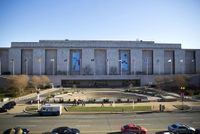Pressure is mounting on the Smithsonian Institution as President Donald Trump’s administration embarks on an unprecedented campaign to reshape the nation’s historical narrative. Under the banner of “Restoring Truth and Sanity to American History,” a March 2025 executive order placed Vice President J.D. Vance at the helm of a sweeping review and purge of what the White House has labeled “divisive” content—particularly narratives addressing race, slavery, and systemic injustice—across the Smithsonian’s vast network of museums.
The initiative, described in an August 12, 2025 letter from three top Trump aides to Smithsonian Secretary Lonnie Bunch III, demands access to internal curatorial documents, exhibition plans, and educational materials from eight major museums. The White House insists on “content corrections” to replace what it calls “ideologically driven” accounts with stories that celebrate “American exceptionalism.” According to CNN, this is part of a comprehensive internal review meant to “remove divisive or partisan narratives and restore confidence in our shared cultural institutions.”
The effects of this campaign have already rippled through the Smithsonian’s flagship museums. ABC News reported on August 1, 2025, that references to Trump’s two impeachments were removed from the National Museum of American History’s “Limits of Presidential Power” exhibit following White House pressure. Trump, the only U.S. president impeached twice—first in 2019 for abuse of power and obstruction of Congress, then in 2021 for incitement of insurrection—saw both proceedings temporarily erased from the museum’s public record. Smithsonian officials claimed the move was a restoration to the exhibit’s 2008 version, but critics argue it was a clear response to political interference.
The National Museum of African American History and Culture has come under even more intense scrutiny. In April, Pulitzer Prize-winning journalist Nikole Hannah-Jones told Black Press USA that the administration’s targeting of the museum’s slavery section “is a sign of a deep sickness.” She added, “To erase or minimize the slavery and freedom part of that story is to create a fantasy of how we got here. We literally would not be in the United States without slavery.”
The controversy escalated when civil rights icon Dr. Amos C. Brown revealed on April 29, 2025, on the Black Press USA’s Let It Be Known show that the museum abruptly returned historic artifacts he had loaned—a Bible from the civil rights era and one of the earliest histories of Black people in America—without discussion. Dr. Brown attributed this to “Project 2025,” stating, “This is a direct result of Project 2025. There is a move in this country to induce cultural and historical Alzheimer’s.”
Despite these extraordinary pressures, Smithsonian Secretary Lonnie Bunch, who has led the institution since 2019, has publicly pledged to “remain committed to telling the multi-faceted stories of this country’s extraordinary heritage.” Bunch’s resolve, however, is being tested by the administration’s demand for authority over not just content, but also funding and even appointments to the Board of Regents—an unprecedented level of federal interference in the Smithsonian’s 178-year history.
For many historians and civil rights leaders, the administration’s moves evoke memories of authoritarian regimes. Hannah-Jones, in her April remarks, warned, “We cannot be a free democratic society when you have the most powerful people in the world who will take control of a history museum and force them to tell a lie.” The sentiment echoes widespread fears that the White House’s campaign is not merely about shifting emphasis but about erasing uncomfortable truths from the American story.
This struggle over historical memory is particularly poignant given the Smithsonian’s origins. James Smithson, the institution’s founder, was a self-made English chemist and mineralogist whose scientific curiosity knew few bounds. According to CNN, Smithson published 27 scientific papers, discovered the mineral smithsonite, and mingled with scientific luminaries such as Joseph Priestley and Andre Lavoisier. In his will, Smithson left his fortune to the United States to found the Smithsonian Institution, declaring, “It is in his knowledge that man has found his greatness and his happiness, the high superiority which he holds over the other animals who inhabit the earth with him, and consequently no ignorance is probably without loss to him, no error without evil.”
Smithson’s vision was clear: the pursuit and dissemination of knowledge, free from political or ideological interference, was essential to human progress. Yet, as critics of the Trump administration’s efforts point out, the current campaign threatens to undermine that very foundation. The White House’s focus on “restoring confidence” in cultural institutions by aligning them with a singular vision of “American exceptionalism” has alarmed many who see it as a direct assault on the diversity and complexity of the nation’s past.
Some see the administration’s actions as reminiscent of the tactics employed by totalitarian states to control historical narratives. As one commentator noted, “This is an attempt to deprive us of knowledge that we already know. It is positively Stalin-esque, applying the genetic research of Trofim Lysenko to American history.” The analogy is stark, but for those who value the Smithsonian’s role as a guardian of collective memory, it feels all too apt.
Meanwhile, the broader context of the Smithsonian’s history offers a sobering reminder of what is at stake. After Congress finally accepted Smithson’s bequest in the 19th century, the original Smithsonian “castle” burned down in 1865, taking most of Smithson’s papers with it. The institution has weathered many storms since, but never before has it faced federal demands for such sweeping control over its content and governance.
In the face of these challenges, voices from across the political spectrum are raising concerns. While the administration insists its review is about removing partisanship and restoring trust, critics argue that erasing references to slavery, systemic injustice, and even Trump’s own impeachments is itself a deeply partisan act—one that risks turning the Smithsonian into an instrument of propaganda rather than a beacon of truth.
As the internal review continues and the White House’s demands grow, the Smithsonian’s future hangs in the balance. Will the institution uphold its founder’s commitment to knowledge and intellectual freedom, or will it yield to political pressure and rewrite the nation’s history? The outcome will shape not only how Americans understand their past, but also how they envision their future.
For now, the debate over the Smithsonian’s direction is far from settled. But as the nation watches, one thing is clear: the battle for control of America’s story is as fierce—and as consequential—as ever.



